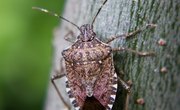
One of the unique aspects of insect biology is their ability to hibernate. This is beneficial in many ways, and is one reason that some members of the insect kingdom have survived for millions of years. The ability to sleep through an extended period of time is part of the growth cycle for some insects, and is a survival skill for others.
Beetles
Many species of beetles are able to hibernate. This is a common trait among these insects, and their reasons for doing so are generally the same. Adult beetles are looking for a secure, dry area that will protect them from both the cold air and any predators that are able to survive the winter, such as spiders. In nature, beetles look for loose bark to burrow under for hibernation. They also spend the winter under piles of fallen leaves and other organic debris for the warmth and safety that this material provides.
The lady beetle is another species that hibernates, both in the larval stage and as adults. The Asian lady beetle (often referred to as ladybugs) winters in cavities in cliff formations in their native homeland, where they are protected from cold winds and winter rain. They adapt to any environment during the winter by finding similar types of housing, such as under the siding of a house.
Flies
Flies are very capable of surviving the winter cold. This is due both to their small size that allows them to crawl into cracks and crevices for warmth and their ability to fly to higher areas that offer protection, such as the eaves of a house. These insects are also prolific reproducers, and their survival rate is increased by the sheer number of active adults that are around during the fall life cycle.
Cluster flies, named for their habit of clustering in large groups during hibernation, are particularly skilled in surviving harsh weather and cold temperatures. They begin to select ideal areas for hibernating during the late summer and early fall, staying warm in whatever secluded enclosure is available when the air begins to turn cold at night. The onset of consistently cold winter air drives them further into shelter to escape the weather change, which is why they are often found in attics and wall voids in a house. They cluster together in these areas, drawing warmth from heated air that is trapped in the wall or that rises to the attic.
Butterflies
Butterflies choose a stage in their life cycle to hibernate according to their species. Some butterfly species, such as the Banded Hairstreak variety, lie dormant in the egg waiting for winter to move on. The Viceroy butterfly hibernates during the larval stage under the soil or inside curled leaves. Mourning Cloaks spend the winter as adults under loose tree bark and in log piles that people store outside their homes. The chrysalis stage is another cycle that some species of butterflies choose for hibernation, despite their vulnerability in this state. Another aspect of butterfly biology that helps them survive is their ability to create chemical substances in their blood, such as glycerol, that acts as a sort of anti-freeze to protect them from extreme cold.
References
About the Author
Greg Jackson is a transcriber, proofreader and editor. Jackson has been writing professionally since 1975, drawing on creative writing courses and personal experiences. His most outstanding work has been as an editor, proofreader and transcriber on two published books, "Douglas Fairbanks: In His Own Words" and "Bohemian Grove: Cult of Conspiracy."
Photo Credits
butterfly image by pearlguy from Fotolia.com
